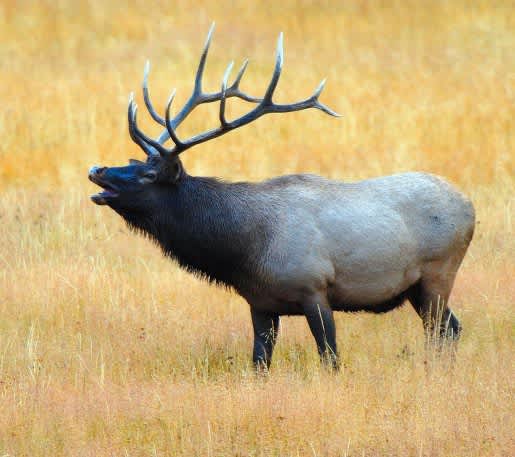Plenty of Bull Elk in Utah says DWR
OutdoorHub 09.22.11

If you’re new to elk hunting, the big game coordinator for the Division of Wildlife Resources has some advice for you. “As soon as the first shots are fired, the elk head away from the roads and into the thickest cover they can find,” says Anis Aoude. “If you want to be a successful elk hunter, you need to get into that cover too.” Utah’s 2011 general rifle bull elk hunt kicks off Oct. 8. And permits for the hunt are almost gone.
On Sept. 19, about 3,400 permits to hunt on any-bull units were still available. About 2,200 permits were also available to hunt on spike-only units. You can buy an elk permit at www.wildlife.utah.gov. Permits are also available at DWR offices and from hunting license agents across Utah.
Elk are doing great
Aoude says the weather over the past eight years has been excellent for elk. “Most of the state’s herds are doing great,” he says.
Based on surveys this past winter, DWR biologists estimated the state’s elk population at more than 72,500 elk.
Aoude says some of the largest elk herds are found on the Central Mountains (Manti) and Wasatch Mountains units in central Utah; the South Slope, Yellowstone unit in northeastern Utah; and the Plateau, Fish Lake/Thousand Lakes unit in south-central Utah.
He says plenty of elk are also found on the Morgan, South Rich unit in northern Utah. But this unit is almost entirely private land. You must obtain written permission from a landowner before hunting on it.
Finding the elk
Most of Utah’s elk hunting takes place on units that are called spike-only units. Spike bulls are the only bulls you may take on these units. Plenty of spike bulls are available on these units. But once the hunt starts, the animals can be tough to find.
“The success rate on spike-only units averages about 17 percent,” Aoude says. “Fortunately, you can do several things to increase the chance you take an elk.”
Unless it gets cold and snowy before the hunt, Aoude says elk will be scattered at higher elevations when the season opens Oct. 8. He says the key to finding them is to get off the roads and into the backcountry.
Aoude says elk are smart, wary animals. “And they’re sensitive to hunting pressure,” he says. “As soon as the shooting starts, they head into the thickest cover they can find. To find success, you have to head into the backcountry and find them.”
The rut (breeding period), which occurs right before the general rifle hunt starts, can also make it challenging to find spike bulls.
During the rut, mature bulls gather groups of cow elk to breed. If one of these large bulls sees a spike bull, he’ll chase the spike bull off.
Being chased into cover by the bigger bulls makes the spike bulls, which are already nervous, more apt to head back into the cover once the bullets start to fly.
“The larger bulls scare the spike bulls as much as the hunters do,” Aoude says. “Unless you get into the backcountry areas where the spikes are hiding, you’re probably not going to see many.
“The good news is, if you do get into the backcountry, there’s a good chance you’ll be among the 17 percent who take a spike bull this year.”
OHV maps – don’t leave home without one
Aoude has an important reminder for elk hunters who will be using off-highway vehicles. “It’s critical that you obtain an OHV riding map for the area you’re going to hunt,” he says. “These maps are available from the agency that manages the land you’ll be hunting on. That agency is usually the U.S. Forest Service or the Bureau of Land Management.”
Aoude says the DWR is receiving more and more complaints about OHVs being taken into areas where it’s not legal to take them. “Taking OHVs into these areas damages the habitat the elk rely on, disturbs and scatters the animals, and ruins the hunting experience for other hunters.”
Aoude also encourages you to do some preseason scouting and to check the boundary descriptions for the areas you’ll be hunting.
Boundary descriptions are available at http://go.usa.gov/83U.
For more information, call the nearest Division of Wildlife Resources office or the DWR’s Salt Lake City office at (801) 538-4700.

